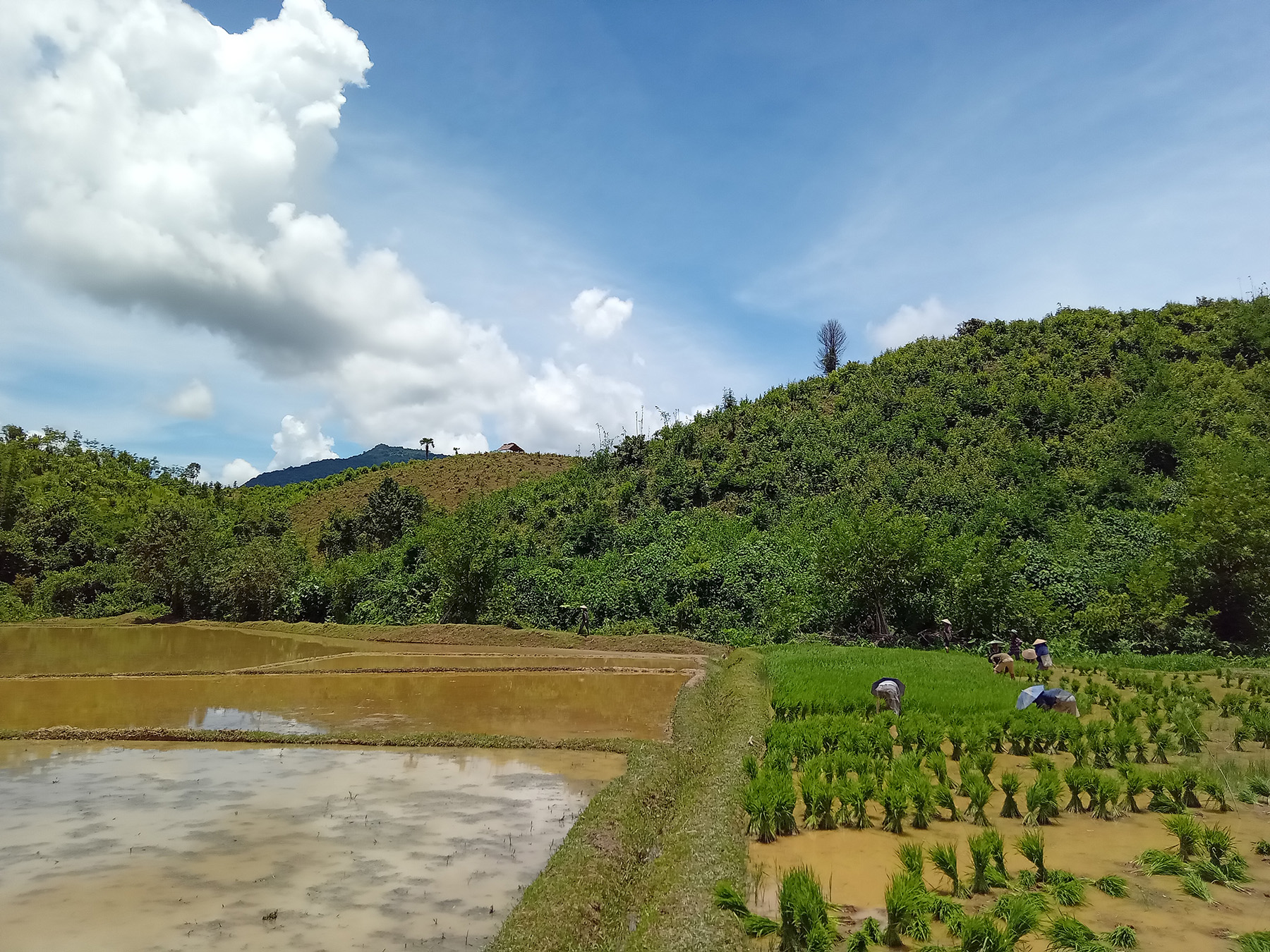Ethnographic vignette about rice-human relatedness in the Luang Prabang Lowlands
“You’ve done enough, go rest!” It is mid-July, rice transplanting season and my first day of fieldwork (literally) in the village of “Naadawn” in northern Luang Prabang province. Mother Naen, her husband Korn, six others and I are out in Naen’s naa (wet-rice field), wading barefoot through ankle-deep mud and shin-deep water. The relentlessly rising forenoon sun has raised the temperature of both mud and water to an unpleasant degree. Bending over to pull the tender bushels from the warm sticky slush, I have left my lower back clumsily exposed. It is already turning blood-red (and will itch, sting and flake for weeks to come). Well acquainted with this hazard, others have prudently wrapped cloth sheets around their waists. My ears and the back of my neck turn are turning red as well. Korn offers me his Vietnamese-style bamboo conical hat. Placing it atop my baseball cap, I feel instant relief. My spine, knees and upper thighs are aching. Crouching next to me, brother Mai senses my increasing agony. “Ot ao” he smiles (Lao shorthand for “take your suffering in stride”). We continue pushing forward; pulling, tying and tossing the lush green bundles beside and behind us. Sun and temperature continue to rise. Unbearable heat. Inescapable heat. “Yensabai, yensabai, sao naa (cool and pleasant, cool and pleasant, wet-rice farmer)” – I start singing, sarcastically, the chorus of a popular Lao folk song. Mai joins in. Laughter. Grasshoppers and dragonflies flee our steadily advancing front. With each of our grips and pulls, spiders hastily abandon the uprooted blades, zigzagging over the now naked water in an increasingly futile search for shade. Between them, fallen, un-sprouted seeds float aimlessly. Ignored and stepped over, some are already rotting away. Forward we move. Not far in front of us – yet a seeming world away – the first blades of kao hai (swidden rice) are protruding from Tongpiang’s hillside swiddens, adding a gentle emerald hue to the upland fallows that frame the narrow lowland pockets throughout this part of Laos. A little more than a week from now, once the wet-rice transplanting is done, we will head up there for the monotonous drudge of hael (weeding the swiddens). I am exhausted, dehydrated, panting, hot. Only pride and desire to build rapport prevent me from following Naen’s advice to “go rest” in the fieldhut.

Eventually, finally, lunch break is called. Sister Suk and her husband San have slaughtered a chicken. Everyone has brought along their eb kao (sticky rice basket). I share Korn and Naen’s. We eat and rest under the shade of the field hut’s corrugated iron roof and surrounding banana trees. Sak passes around our only cup (a sawn-off pepsi bottle) for patient turns gulping down lukewarm water cautiously poured from a blue 20-litre plastic canister. The canister’s much-weathered brand label features a crude stencil of a rural landscape, much like the one we are in right now. “District Drinking Water Factory – Pure and Clean” the caption reads. “This water is bland and stale” Naen sighs to widespread agreement, “before, we just drank from the streams nearby, but now we are no longer confident, the Chinese are mining, looking for gold… so we buy this water, now everything costs money!”
Mai meanwhile is already back at work; ploughing away with his kwaai lek (“iron buffalo” – slang for the mechanized ploughs now ubiquitous throughout Laos). In a few days, we will separate and push the bundles we’ve just uprooted into that overturned patch of earth. “Oh, before, when we ploughed with real buffaloes, our naa were full of frogs and crabs” Naen announces, “there were more than you could hope to catch or eat! Now the kwaai lek make so much noise, all the animals have run away. So we bring a chicken…”
“Yes, but back then ploughing took a month!” Korn chimes in, “now we’re done in a few days!”
“What variety of rice is this” I ask, pointing to our morning’s work.
“Kao maakgork noi (small hog plum rice)” Korn replies.
“Why do you grow this variety?”
“Because it’s kao-kang” Korn explains, alluding to the widespread (but often vague) grouping of rice into early/fast-maturing (kao-tor), medium-maturing (kao-kang) and late/slow-growing (kao-bii) varieties; “so we can harvest it just after our kao hai, in early November… and it stays straight [i.e. is not pushed over by wind] so it’s easy to reap… we grow kao maakgork noi because we can get it done quickly and than ladugaan [roughly: keep up with the working seasons]; produce vegetables, cucumbers, cabbage, watermelons, raise livestock, go work on the [nearby Chinese] banana plantation, do this, do that… nowadays, nobody plants kao bii anymore!”
“But before we did” Naen interjects, “sometimes we would still be harvesting in late January, when it was cold already, yensabai! Before, we only had two wiak [tasks]: growing rice and looking for fish and crabs in the streams… it was hard, but we than [managed/kept up], we had no money, but we didn’t need any, we had time!”
“Yes” Korn continues, “but this is the era of development, the era of the market, of science, the era of handbooks/manuals [samai kumeu]… we are always looking for money, every day, so we don’t have time for rice anymore, we don’t have time for kao-bii!”
Before long, we are back in the naa, bent over under the sun, plucking away at kao maak gork noi.
